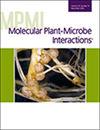Damaris Barminga, Sylvia Mutinda, Fredrick M Mobegi, Willy Kibet, Brett Hale, Sylvester Anami, Asela Wijeratne, Emily S Bellis, Steven Runo
求助PDF
{"title":"Cell Wall Dynamics in the Parasitic Plant (<i>Striga</i>) and Rice Pathosystem.","authors":"Damaris Barminga, Sylvia Mutinda, Fredrick M Mobegi, Willy Kibet, Brett Hale, Sylvester Anami, Asela Wijeratne, Emily S Bellis, Steven Runo","doi":"10.1094/MPMI-06-24-0064-FI","DOIUrl":null,"url":null,"abstract":"<p><p>In the plant-plant pathosystem of rice (<i>Oryza sativa</i>) and the parasitic plant <i>Striga hermonthica</i>, cell walls from either plant are important defensive and offensive structures. Here, we reveal the cell wall dynamics in both <i>Striga</i> and rice using simultaneous RNA sequencing. We used weighted gene co-expression network analysis to home in on cell wall modification processes occurring in interactions with a resistant rice cultivar (Nipponbare) compared with a susceptible one (IAC 165). Likewise, we compared the cell wall dynamics in <i>Striga</i> infecting resistant and susceptible rice. Our study revealed an intense battlement at the <i>Striga-</i>rice cell walls involving both parasite (offense) and host (defense) factors, the outcome of which makes the difference between successful or failed parasitism. <i>Striga</i> activates genes encoding cell wall-degrading enzymes to gain access to the host, expansins to allow for cell elongation, and pectin methyl esterase inhibitors for rigidity during infection. In the susceptible host, immune response processes are not induced, and <i>Striga</i>-derived cell wall-degrading enzymes easily breach the host cell wall, resulting in successful parasitism. In contrast, the resistant host invokes immune responses modulated by phytohormones to fortify the cell wall through polysaccharides and lignin deposition. Through these processes, the cell wall of the resistant host successfully obstructs parasite entry. We discuss the implications of these findings in the context of practical agriculture in which cell wall modification can be used to manage parasitic plants. [Formula: see text] Copyright © 2025 The Author(s). This is an open access article distributed under the CC BY-NC-ND 4.0 International license.</p>","PeriodicalId":19009,"journal":{"name":"Molecular Plant-microbe Interactions","volume":" ","pages":"285-296"},"PeriodicalIF":3.4000,"publicationDate":"2025-03-01","publicationTypes":"Journal Article","fieldsOfStudy":null,"isOpenAccess":false,"openAccessPdf":"","citationCount":"0","resultStr":null,"platform":"Semanticscholar","paperid":null,"PeriodicalName":"Molecular Plant-microbe Interactions","FirstCategoryId":"99","ListUrlMain":"https://doi.org/10.1094/MPMI-06-24-0064-FI","RegionNum":3,"RegionCategory":"生物学","ArticlePicture":[],"TitleCN":null,"AbstractTextCN":null,"PMCID":null,"EPubDate":"2025/4/14 0:00:00","PubModel":"Epub","JCR":"Q2","JCRName":"BIOCHEMISTRY & MOLECULAR BIOLOGY","Score":null,"Total":0}
引用次数: 0
引用
批量引用
Abstract
In the plant-plant pathosystem of rice (Oryza sativa ) and the parasitic plant Striga hermonthica , cell walls from either plant are important defensive and offensive structures. Here, we reveal the cell wall dynamics in both Striga and rice using simultaneous RNA sequencing. We used weighted gene co-expression network analysis to home in on cell wall modification processes occurring in interactions with a resistant rice cultivar (Nipponbare) compared with a susceptible one (IAC 165). Likewise, we compared the cell wall dynamics in Striga infecting resistant and susceptible rice. Our study revealed an intense battlement at the Striga- rice cell walls involving both parasite (offense) and host (defense) factors, the outcome of which makes the difference between successful or failed parasitism. Striga activates genes encoding cell wall-degrading enzymes to gain access to the host, expansins to allow for cell elongation, and pectin methyl esterase inhibitors for rigidity during infection. In the susceptible host, immune response processes are not induced, and Striga -derived cell wall-degrading enzymes easily breach the host cell wall, resulting in successful parasitism. In contrast, the resistant host invokes immune responses modulated by phytohormones to fortify the cell wall through polysaccharides and lignin deposition. Through these processes, the cell wall of the resistant host successfully obstructs parasite entry. We discuss the implications of these findings in the context of practical agriculture in which cell wall modification can be used to manage parasitic plants. [Formula: see text] Copyright © 2025 The Author(s). This is an open access article distributed under the CC BY-NC-ND 4.0 International license.
寄生植物(Striga)细胞壁动力学与水稻病理系统。
在水稻(Oryza sativa)和寄生植物Striga hermonthica的植物-植物病理系统中,任一植物的细胞壁都是重要的防御和进攻结构。在这里,我们揭示了细胞壁动力学在Striga和水稻同时使用RNA测序。我们使用加权基因共表达网络分析(WGCNA)来研究抗性水稻品种(Nipponbare)与敏感水稻品种(IAC 165)相互作用时细胞壁修饰过程。同样地,我们比较了抗和易感水稻中Striga侵染的细胞壁动态。我们的研究揭示了稻曲菌细胞壁的激烈战斗涉及寄生虫(进攻)和宿主(防御)因素;其结果决定了寄生成功与否。Striga激活编码细胞壁降解酶(CWDEs)的基因以进入宿主;扩张蛋白允许细胞伸长和果胶甲基酯酶抑制剂在感染期间刚性。在易感宿主中,没有诱导免疫反应过程,Striga衍生的CWDEs很容易破坏宿主细胞壁,从而成功寄生。相反,抗性寄主调用由植物激素调节的免疫反应,通过多糖和木质素沉积来强化细胞壁。通过这些过程,抗性宿主的细胞壁成功地阻止了寄生虫的进入。我们讨论了这些发现在实际农业背景下的意义,其中细胞壁修饰可用于管理寄生植物。
本文章由计算机程序翻译,如有差异,请以英文原文为准。

 求助内容:
求助内容: 应助结果提醒方式:
应助结果提醒方式:


